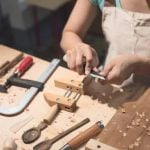Woodworking tools are an essential investment for any woodworking enthusiast or professional. However, one of the biggest threats to these valuable tools is rust. In this article, we will explore how to protect woodworking tools from rust and the detrimental effects of allowing rust to develop on these tools.
Rust can cause irreversible damage to woodworking tools, leading to decreased performance and potentially rendering them unusable. Understanding the factors that contribute to rust formation is crucial in preventing it from occurring in the first place. By learning about the nature of rust and how it forms on metal tools, woodworkers can take proactive measures to keep their tools rust-free.
In the following sections, we will provide practical tips for preventing rust, including proper cleaning and maintenance routines, storage techniques, protective coatings and treatments, as well as the use of rust inhibitors. Additionally, we’ll address common issues related to rust on woodworking tools and offer effective solutions for dealing with these problems. Let’s delve into the importance of protecting woodworking tools from rust and discover actionable strategies for ensuring their longevity and performance.
Understanding Rust
Rust is the enemy of all metal tools, and woodworking tools are no exception. Understanding what rust is and how it forms on metal tools is crucial for protecting woodworking tools from corrosion. Rust is a reddish-brown oxide that forms on iron or steel when exposed to oxygen and moisture.
When these two elements come into contact with metal, they create a chemical reaction that results in the formation of rust. This process can be accelerated by high humidity levels, salty air, and other environmental factors.
Factors that contribute to rust formation include exposure to water or moisture, high humidity levels, and prolonged contact with corrosive materials. Woodworking tools that are not properly dried after use or stored in damp environments are particularly prone to rust. Understanding these contributing factors can help woodworkers take proactive measures to prevent rust from forming on their tools.
Preventive Measures
To protect woodworking tools from rust, it’s essential to take preventive measures. This includes keeping tools dry and ensuring they are cleaned and stored properly after each use. Additionally, using protective coatings, treatments, and rust inhibitors can help create a barrier between the metal surface of the tools and potential sources of corrosion.
Cleaning Methods
Regular cleaning is key to preventing rust on woodworking tools. After each use, it’s important to remove any debris or residue from the tool surface, as these can trap moisture and accelerate the formation of rust. Using a clean cloth or brush to wipe down the tools before storing them can go a long way in preventing oxidation.
Maintenance Practices
In addition to regular cleaning, maintaining woodworking tools also involves inspecting them for signs of corrosion or damage. Any nicks or scratches should be addressed promptly to prevent further deterioration of the metal surface. Implementing a maintenance routine that includes lubricating moving parts and periodically applying protective coatings will help keep woodworking tools free from rust for years to come.
By understanding what causes rust and taking proactive steps to prevent its formation, woodworkers can safeguard their valuable tools from corrosion and ensure their longevity in the workshop.
Tips for Preventing Rust
Woodworking tools are an essential investment for any woodworker, and protecting them from rust is crucial to ensure their longevity and performance. Rust can cause irreversible damage to tools, leading to deterioration and even rendering them unusable. Understanding how to protect woodworking tools from rust is essential for maintaining their quality and usability.
One of the most effective ways to prevent rust on woodworking tools is by keeping them clean and dry. After each use, it’s important to remove any moisture or debris from the tools and store them in a clean, dry environment. Additionally, applying a thin layer of protective oil or wax can help create a barrier against moisture and prevent rust from forming.
Regular maintenance of woodworking tools is also critical in preventing rust. This includes inspecting the tools for any signs of corrosion, sharpening blades as needed, and storing them in a proper manner. By incorporating these practices into a routine maintenance schedule, woodworkers can effectively protect their tools from rust and ensure their longevity.
Another way to protect woodworking tools from rust is by investing in protective coatings or treatments specifically designed for metal surfaces. These coatings can provide an extra layer of defense against moisture and corrosion, ultimately extending the lifespan of the tools. Applying these coatings according to the manufacturer’s instructions can significantly reduce the risk of rust formation on woodworking tools.
| Preventative Measure | Details |
|---|---|
| Cleaning and Drying | Remove moisture and debris after use; store in clean, dry environment |
| Maintenance | Regular inspections, sharpening, proper storage |
| Protective Coatings/Treatments | Invest in specialized coatings for metal surfaces |
Proper Storage Techniques
Woodworking tools are susceptible to rust if not stored properly. Moisture and air exposure can accelerate rust formation, leading to damage and deterioration of the tools. Therefore, it is crucial to implement proper storage techniques to protect woodworking tools from rust. Here are some tips for effective storage:
1. Keep tools in a dry environment: Store woodworking tools in a dry area to minimize moisture exposure. Consider using a dehumidifier in the storage space if necessary.
2. Use desiccants or moisture-absorbing materials: Place desiccants such as silica gel packets or moisture-absorbing materials like activated charcoal in toolboxes or storage containers to absorb any excess moisture.
3. Invest in tool cabinets or chests: Consider investing in tool cabinets or chests with built-in moisture barriers to provide an additional layer of protection against rust.
4. Hang tools on pegboards or racks: Hanging tools on pegboards or racks instead of leaving them in piles can promote better air circulation around the tools, reducing the risk of rust formation.
5. Apply rust-resistant coatings: Before storing your woodworking tools, ensure they are clean and dry, then apply a thin layer of rust-resistant coating such as paste wax or mineral oil to provide an extra barrier against moisture and oxidation.
By following these proper storage techniques, woodworkers can significantly reduce the risk of rust formation on their valuable woodworking tools, ultimately prolonging their lifespan and preserving their functionality over time.
For more information on how to protect woodworking tools from rust, take a look at our other blog posts that cover tips for preventing rust and appropriate cleaning and maintenance routines for woodworking tools.
Protective Coatings and Treatments
Woodworking tools are essential for any woodworker, and protecting them from rust is crucial to ensure their longevity and performance. Rust can cause irreversible damage to metal tools, leading to corrosion, reduced effectiveness, and even safety hazards. Understanding how to protect woodworking tools from rust is vital for preserving their quality and maintaining a safe working environment.
Rust forms when metal comes into contact with moisture and oxygen over time. Factors such as high humidity, exposure to water or damp environments, and improper storage can accelerate the process of rust formation on woodworking tools. To prevent this, it is important to implement proactive measures to protect the tools from moisture and oxidation.
One effective way to shield woodworking tools from rust is by applying protective coatings and treatments. There are various options available, including wax coatings, oil-based treatments, and specialized rust-resistant products designed for metal surfaces.
These coatings act as a barrier between the tool’s metal surface and external elements, preventing moisture and oxygen from causing rust. By regularly applying these treatments according to the manufacturer’s instructions, woodworkers can significantly extend the lifespan of their tools and reduce the risk of rust formation.
In addition to applying protective coatings and treatments, it is important to follow proper storage techniques for woodworking tools. Storing them in a dry and well-ventilated area can further minimize the risk of rust development. By combining these strategies with regular cleaning and maintenance routines, woodworkers can effectively protect their valuable tools from rust and ensure optimal performance for years to come.
Using Rust Inhibitors
Rust inhibitors are a crucial tool in preventing rust formation on woodworking tools. These products work by creating a protective barrier on the metal surface, preventing moisture and oxygen from coming into contact with the metal and causing rust. Understanding how to use rust inhibitors effectively can help prolong the life of your woodworking tools and keep them in top condition for years to come.
Here are some steps for using rust inhibitors to protect your woodworking tools:
- Clean the Tools: Before applying any rust inhibitor, it’s essential to start with clean, dry tools. Use a mild detergent and water to clean off any dirt or grime from the surfaces of the tools. Dry them thoroughly before moving on to the next step.
- Apply the Rust Inhibitor: Once your tools are clean and dry, it’s time to apply the rust inhibitor. You can choose from various types of inhibitors, including sprays, waxes, or oils. Follow the manufacturer’s instructions for application carefully, making sure to coat all exposed metal surfaces evenly.
- Allow Time for Penetration: After applying the rust inhibitor, allow it time to penetrate the metal surface. This will ensure that it forms a strong protective barrier against moisture and oxygen. Depending on the type of inhibitor you’re using, this may take a few hours or even overnight.
- Regular Re-application: Keep in mind that rust inhibitors may wear off over time, especially if your tools are frequently exposed to moisture or humidity. It’s important to regularly reapply the inhibitor as recommended by the manufacturer to maintain its effectiveness.
By following these steps and incorporating rust inhibitors into your tool maintenance routine, you can effectively protect your woodworking tools from rust and extend their lifespan.
Cleaning and Maintenance Routine
Regular Cleaning
One of the most important steps in protecting woodworking tools from rust is to establish a regular cleaning routine. After each use, it is crucial to thoroughly clean the tools to remove any sawdust, debris, and moisture that may have accumulated during the work session. Use a dry cloth or brush to wipe down the tools and ensure that they are completely dry before storing them.
Applying Lubrication
Applying a thin layer of lubricant or oil to metal woodworking tools can help prevent rust formation. After cleaning the tools, it is recommended to apply a light coat of oil or lubricant to provide a protective barrier against moisture and humidity. Be sure to wipe off any excess oil and store the tools in a dry environment.
Maintaining Sharpness
Keeping woodworking tools sharp not only ensures better performance but also helps in preventing rust. Dull blades and edges are more prone to rust as they are not as efficient at cutting through materials, which can lead to moisture retention on the surfaces. Regular sharpening and honing of woodworking tools can help maintain their condition and reduce the risk of rust formation.
By implementing these cleaning and maintenance routines, woodworkers can effectively protect their valuable tools from rust and prolong their lifespan. Consistent care and attention to detail will go a long way in keeping woodworking tools in top condition for years to come.
Troubleshooting Rust Issues
Rust is the enemy of all metal tools, and woodworking tools are no exception. The presence of rust not only affects the appearance of the tools but also significantly reduces their functionality and lifespan. This section will address common issues related to rust on woodworking tools and provide effective solutions and tips for dealing with these problems.
One common issue woodworkers encounter is finding minor spots of rust on their tools despite their best efforts to prevent it. These can be particularly frustrating, as they usually appear after a period of non-use or improper storage. In such cases, it is important to act quickly to remove the rust and prevent it from spreading further.
To deal with small outbreaks of rust, fine steel wool or sandpaper can be used to scrape away the surface rust from the affected area. After removing the rust, applying a thin layer of mineral oil or a commercial lubricant can help protect the tool from further corrosion. It’s important to ensure that the affected area is completely dry before applying any protective coating.
Another issue that woodworkers may face is more severe rusting, where larger areas of their tools are affected. In such cases, using a rust remover solution or naval jelly can help dissolve heavy rust buildup. After applying the remover, scrubbing with a stiff brush and rinsing thoroughly with water can help restore the tool’s surface. Once cleaned, proper drying and application of protective coatings are essential in preventing future occurrences.
Dealing with rust issues requires patience and diligence, but by following these troubleshooting tips, woodworkers can effectively combat rust problems and ensure their woodworking tools remain in top condition.
| Rust Issue | Solution |
|---|---|
| Minor spots of rust | Remove surface rust with steel wool or sandpaper; apply mineral oil or commercial lubricant for protection |
| Severe rusting | Use a rust remover solution or naval jelly; scrub with stiff brush; rinse thoroughly; apply protective coatings after drying |
Conclusion
In conclusion, protecting woodworking tools from rust is essential in preserving their longevity and performance. Rust can have damaging effects on metal tools, leading to deterioration and reduced effectiveness. By understanding what rust is and the factors that contribute to its formation, woodworkers can take proactive steps to prevent it.
Following the tips for preventing rust, such as regular cleaning and maintenance, proper storage techniques, and using protective coatings and treatments, can significantly reduce the risk of rust formation on woodworking tools. Additionally, incorporating rust inhibitors into the maintenance routine can provide an extra layer of protection against corrosion.
It is important for woodworkers to prioritize a regular cleaning and maintenance routine for their tools, as well as being knowledgeable about troubleshooting rust issues when they arise. By taking proactive measures to protect woodworking tools from rust, woodworkers can ensure that their tools remain in optimal condition for years to come.
Frequently Asked Questions
What Can I Coat My Tools With to Prevent Rust?
One common coating to prevent rust on tools is a thin layer of oil. This can be applied to metal surfaces to create a barrier against moisture and oxygen, which are the main causes of rust. Some people also use specialized rust-preventative coatings or waxes for added protection.
What Is the Best Oil to Protect Woodworking Tools?
Many woodworking professionals and hobbyists swear by using boiled linseed oil to protect their woodworking tools. It penetrates the wood, seals it, and protects it from moisture and wear. Mineral oil is another popular option for protecting wooden tools as it is non-toxic and food-safe.
What Is the Best Spray to Prevent Rust on Tools?
There are various rust-preventative sprays available on the market that are specifically designed to protect tools from corrosion. Look for products that offer long-lasting protection, are easy to apply, and provide a thin protective layer without interfering with the tool’s functionality.
It’s also important to consider if the spray is compatible with the material of your tools.

Hi everyone! I’m a woodworker and blogger, and this is my woodworking blog. In my blog, I share tips and tricks for woodworkers of all skill levels, as well as project ideas that you can try yourself.





